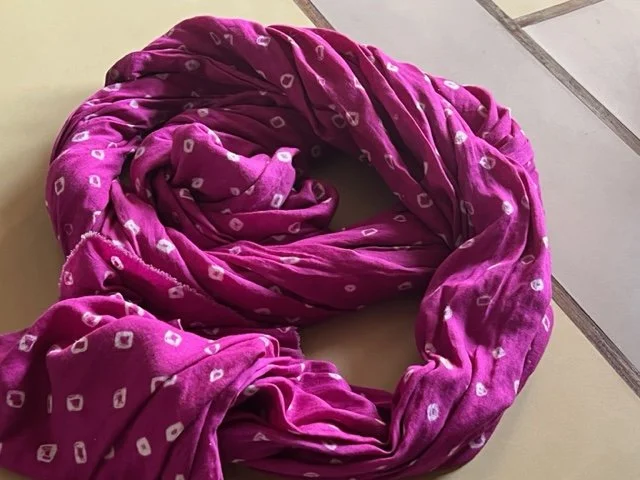My patta, your patta — Dupatta?
When my friend Pragna gave me this lovely item above for Christmas one year, I had to ask her about 3 times — maybe 5 times — maybe 10 times — what it was called. She patiently told me, again and again, that it is a dupatta, or large scarf, worn by Indian women. I must have looked puzzled (even though I love scarves). It was bigger and longer and thicker than I was used to. Pragna showed me different ways to wear it, and explained it multiple purposes — handkerchief, tissue, napkin, rain cover, sun and wind protector, shoulder cover. Napkin? Hmmmmm. I listened, and I liked it, but I still couldn’t really remember what it was called . . . or understand its importance.
Then, the fall semester before I left for India on the Fulbright-Nehru scholarship, this lovely and mysterious item bubbled up in my dressing room — I rediscovered it. Well, what better way to celebrate that I would soon have a break from my regular routine at Daemen University than to start wearing my Indian dupatta? Regardless of my teaching outfit for the day, I wore the dupatta every single day in the fall semester of 2022.
After arriving in Delhi on January 3rd, I was cold. Many of my friends at home were puzzled when I sent them pictures of me — in a hat, all bundled up. Delhi has a very chilly winter, and January 2023 was one of its coldest, with temperatures getting down to 42 degrees. Although that may not sound that cold to my friends back in Buffalo, most Delhi buildings — including my apartment — were not constructed with central heating, because the winters are so short, perhaps — so we relied on space heaters to heat the rooms.
The temperatures made the dupatta even more important, and I continued wearing it every day until I could buy a wool one. I was still puzzled by the multiple uses explained by Pragna, but I loved watching the beautiful outfits worn by Indian women as I commuted to work on the metro — especially the gorgeous dupattas.
And I started to remember what it was called — after all, I heard the word all the time now, and was thrilled to recognize it in the metro announcement in Hindi that warned women to make sure their dupattas didn’t get caught in the train doors.
I also started to notice that, unlike the United States, there was not mountains of paper products available everywhere — there were not containers of paper napkins when I went out to eat or at the girls’ hostel where I ate lunch at NLUD, and there were often no paper towels in the washrooms. This reminded me of my stay on the Caribbean coast of Costa Rica in Puerto Viejo where I also noticed there weren’t paper goods oozing out of every tabletop and bathroom. I wondered why.
According to a 2018 article in The Atlantic, the U.S. spends about $5.7 billion on paper towels a year, which is almost half of the $12 billion of global spending on paper towels. Single-use paper products. While having lunch with my friend Shardool in the NLU Delhi cafeteria, I asked him why there weren’t any napkins in the school canteen. “Oh” he replied “we just wash our hands.”
Then I noticed that there were sinks with soap in every eating place on campus, and often in restaurants in the common area. And I remembered all the uses of the dupatta — which included napkin. And I resolved to buy less paper towels when I returned to the U.S.
At the Fulbright conference in Kochi wearing my favorite green dupatta!

